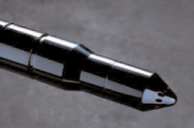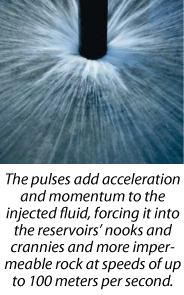
According to the Department of Energy, up to 430 billion barrels of recoverable oil lay right here in the United States.
Exactly how much oil is this?
It’s…
- 2x more than all the reserves of Saudi Arabia
- 6x more than Mother Russia
- More than Iraq, Iran, Kuwait, and Canada combined!
All of which makes it even harder to understand why we’re still dependent on any one of these countries for our oil.
The truth is it’s not because of politics… but simply because this oil is too difficult to extract.
You see, most people are surprised to learn that when it comes to crude, oil companies typically recover only the “low-hanging fruit”: just 10% to 20% of the oil in proven reserves.
That’s it. The rest is either too difficult or too costly to extract.
Think about that: Up to 90% of proven oil is simply abandoned by profit-hungry oil companies!
Now just imagine what it would mean if these companies could finally get to all this “leftover” oil.
If only they had the right technology…
If only the right technology even existed…
I’m here to tell you that it does.
What’s more, it’s already being used by some of the biggest oil companies on the planet…
Some of which are using it to increase individual well production by as much as 1000%!
No wonder an analyst with Max Capital Markets wrote:
“The potential for this technology to be adopted by an entire industry is huge.”
Just as another recent technology — horizontal fracturing — has opened up so much natural gas in North America that there’s not even enough room to store it, so too will this new technology unleash billions and billions of barrels of domestic oil.
But first, let me show you the breakthrough technology that could easily allow the United States to triple its oil production almost overnight.
The “Earthquake” Effect
To understand how this technology works, it’s important to realize why it’s so difficult for producers to reach more than 20% of the oil beneath their feet.
To extract the oil, companies inject hundreds of thousands of gallons of water and carbon dioxide into the ground to push it into another well where it can be pumped out.
But instead of acting as one massive wave of pressure throughout the entire formation, water and CO2 flow the path of least resistance, with much of it seeping away into tiny rivers and nooks and crannies in the earth.
The result is that only a fraction of the oil can be recovered before there is nothing left but water and CO2.
Until physicists realized something…
For years, whenever an earthquake hit Alaska, oil production in the Western Canadian Sedimentary Basin soared.
Why?
Well, the closest explanation was that massive waves of energy moving at hundreds of meters a second were bound to break apart rock formations containing oil.
But that posed another question…
What if this same seismic energy could be safely stimulated to extract more oil?
In the late 90s, with oil still at $12 at barrel, one tiny company put this question to the test.
And the answer it came up with was a device so mind-bogglingly simple that it can be used right out of the box!

All oil producers need to do is attach this device to the bottom of a fluid injection string…
Then this “Petro-Pusher” relentlessly pulses water through the ground at speeds of up to 100 meters per second.

It’s this lightning-fast, nonstop pressure that forces thousands of more barrels of oil to the surface faster thanany other extraction method that has ever existed.
And it’s why, in some cases, the Petro-Pusher has increased individual well production as much as 1,000% — and secondary field recovery by 30% or more…
Last year, Core Energy almost doubled oil production at its carbonate pinnacle reef field from 46 barrels of oil per day (bpd) to 84 bpd…
At a formation in Crane County, TX, production soared 30%…
A Canadian operator in Alberta increased production by 52%…
Another operator based in Calgary increased production by 56%…
Small wonder why the Petro-Pusher is already being used by giants like Chevron, Penn West, Apache, BP, Halliburton, and others at more than 175 wells across North America…
Or why the number of drilling stations equipped with it has soared 3,300% since 2007.
Today, America…
Tomorrow, the World
As exciting as all of this is, it’s just the beginning.
After all, extraction difficulties aren’t just a problem in the United States…
A whopping 65% of all the world’s proven oil reserves are also abandoned.
Now, just imagine what it would mean if companies could suddenly reach this oil.
Well, the folks over at BP don’t have to imagine…
According to a company memo:
The prize in enhancing recovery rates is enormous…
a 5% increase in recovery – a conservative increase thought to be achievable – would yield an additional 300 to 600 billion barrels.
Think about that for a minute…
The United States, the largest consumer of oil on the planet, plows through about 6 billion barrels per year.
Even at the low end of BP’s estimates, you’re looking at one company’s ability to produce enough oil to meet demand for more than 50 years.
And here’s the best part: It can all be done without drilling a single well.
That’s why oil companies are lining up for this technology.
The cost to find, drill, and develop a new oil field can total well over $20 billion.
The rentals on deepwater platforms alone run about a half million dollars per day!
And forget about all the regulatory issues involved with drilling new wells… These wells already exist.
All producers like BP have to do is use the Petro-Pusher at those old wells that still have a wealth of oil just sitting there, waiting to be extracted…
About Energy and Capital
Every day, we publish commentary, research, and investment ideas centered around the end of the oil age and the technologies that will help us make a smooth transition. For more information about the newsletter, check out our frequently asked questions.
Membership also ensures you have every opportunity to join our paid advisory services, which have been helping investors maximize energy profits for years.
You can sign up for the newsletter here.












